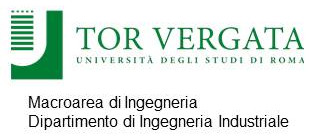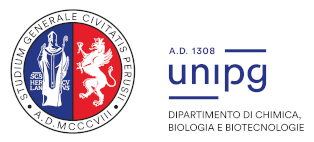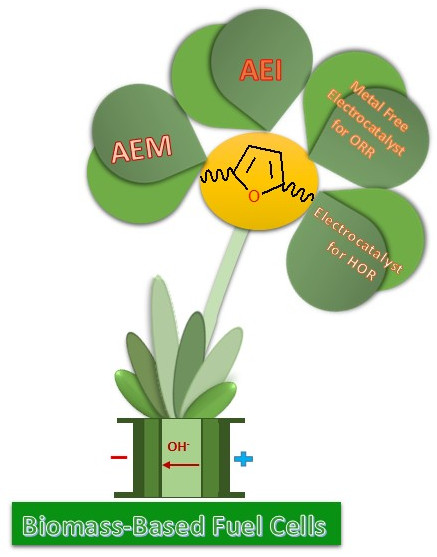The Project
Brief description of the project
Fuel cells will have a crucial role in a more sustainable and green economy, to produce the energy by renewable sources and reduce greenhouse gas emissions.
Anion exchange membranes fuel cell (AEMFC) have significant potential advantages with respect to other FC technologies. However, a more sustainable FC, to obtain not only environmental benefits for the production of renewable energy, must move towards sustainable materials with a composition of abundant and easily accessible elements, and with production possibilities based on renewable raw materials.
The main objective of GreenCore is to set-up a sound approach to the development of core components of eco-friendly AEMFC, exploiting biomass resources, employing green technologies, and finding alternative greener materials.
Objectives
Realizing the core components of an anionic exchange membrane fuel cell (membranes and electrodes) by exploiting biomass resources with innovative green chemistry.
The compliance with the green chemistry guidelines will ensure that the targeted products are genuinely sustainable since it implies optimizing processing and product design to avoid waste and inadvertent environmental damage, besides replacing unsustainable feedstocks.

Environmental impact
GreenCore will fully address the principle of DNSH since it focuses on green and sustainable methodologies to hydrogen production. The climate change we have been facing in recent years has led to a growing awareness of man-made damage and its consequences for future generations. One of the main causes of the increase in global average temperatures is due to the greenhouse gas, which is mostly generated by the combustion of fossil energy carriers. The production and use of clean energy is then mandatory (Paris Agreement in 2015 and COP27 2022 Egypt). In agreement with Europe’s climate change mitigation targets, hydrogen has a strategic importance in the development of a low-emission, environmentally friendly, and more sustainable energy system.
Anionic exchange membrane fuel cells (AEMFC) seem very promising because they allow low or zero PGM levels. However, considering the current state-of-the-art and the low level of technological readiness (TRL) for AEMFC, there is significant potential to improve production emissions, as the development of the technology will lead to less material intensity and cleaner production routes. In this context, the GreenCore project can make a contribution linked to sustainability and environmental protection.
Scientific and technological impacts
Proof-of-concept of “fully green” fuel cell technology.
With this research project, we are promoting a symbiosis between a green energy source and green chemistry, that efficiently uses renewable raw materials, minimizing waste and avoiding the use of toxic and hazardous substances in the design-manufacturing-application of chemicals or materials.
Social impacts
- The Italian “Hydrogen Strategy” sets a medium and a long-term objective, according to which the national energy consumption is expected to consist of 2% hydrogen by 2030 and 20% by 2050. It can be assumed that the demand for FC will increase dramatically in the future, along with the need for CRM for their production. With this project, we are providing a contribution towards ensuring that FC can be manufactured in high volumes in a resource-efficient, green and cost-effective manner
- Improve public perception of the scientific and societal impact of new technologies by a coherent communication strategy of outcomes, and promoting green technologies-related education and training programmes
Workplan
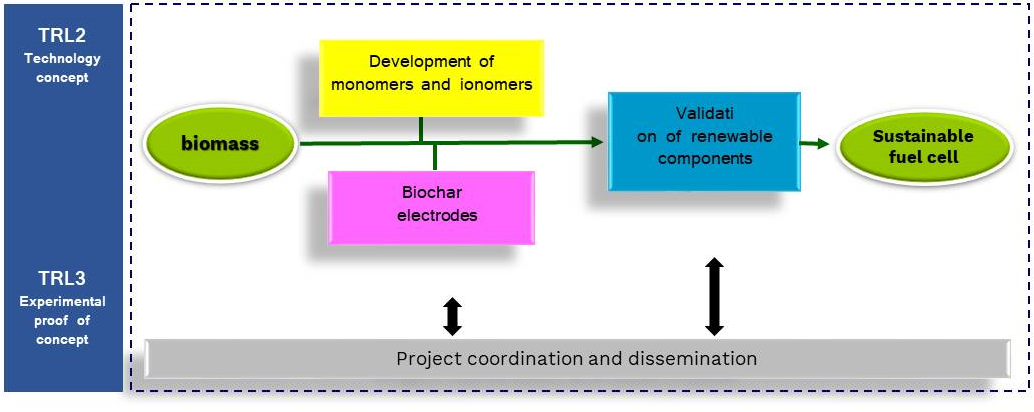
Public documents
Hydrochar from Pine Needles as a Green Alternative for Catalytic Electrodes in Energy Applications
Published on: MOLECULES. Volume 29 Issue 14. DOI 10.3390/molecules29143286
Authors: Marrocchi, A ; Cerza, E ; Chandrasekaran, S ; Sgreccia, E ; Kaciulis, S ; Vaccaro, L ; Syahputra, S ; Vacandio, F; Knauth, P; Di Vona, M.L.
Abstract
Hydrothermal carbonization (HTC) serves as a sustainable method to transform pine needle waste into nitrogen-doped (N-doped) hydrochars. The primary focus is on evaluating these hydrochars as catalytic electrodes for the oxygen reduction reaction (ORR) and carbon dioxide reduction reaction (CO2RR), which are pivotal processes with significant environmental implications. Hydrochars were synthesized by varying the parameters such as nitrogen loading, temperature, and residence time. These materials were then thoroughly characterized using diverse analytical techniques, including elemental analysis, density measurements, BET surface area analysis, and spectroscopies like Raman, FTIR, and XPS, along with optical and scanning electron microscopies. The subsequent electrochemical assessment involved preparing electrocatalytic inks by combining hydrochars with an anion exchange ionomer (AEI) to leverage their synergistic effects. To the best of our knowledge, there are no previous reports on catalytic electrodes that simultaneously incorporate both a hydrochar and AEI. Evaluation metrics such as current densities, onset and half-wave potentials, and Koutecky–Levich and Tafel plots provided insights into their electrocatalytic performances. Notably, hydrochars synthesized at 230 °C exhibited an onset potential of 0.92 V vs. RHE, marking the highest reported value for a hydrochar. They also facilitated the exchange of four electrons at 0.26 V vs. RHE in the ORR. Additionally, the CO2RR yielded valuable C2 products like acetaldehyde and acetate. These findings highlight the remarkable electrocatalytic activity of the optimized hydrochars, which could be attributed, at least in part, to their optimal porosity.
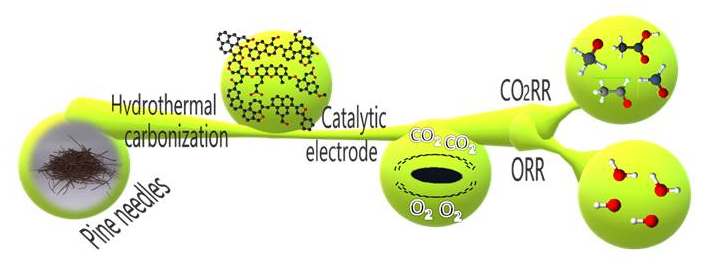
The Team
